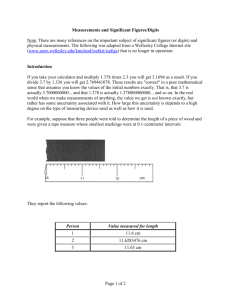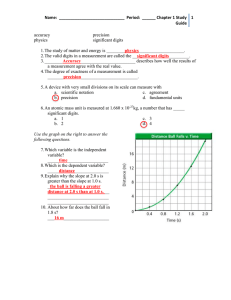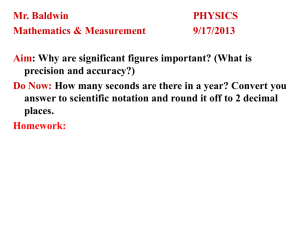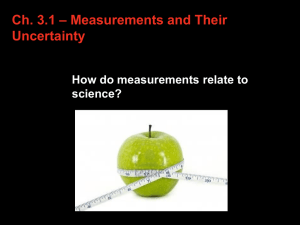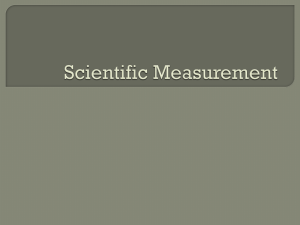Math Notes
advertisement
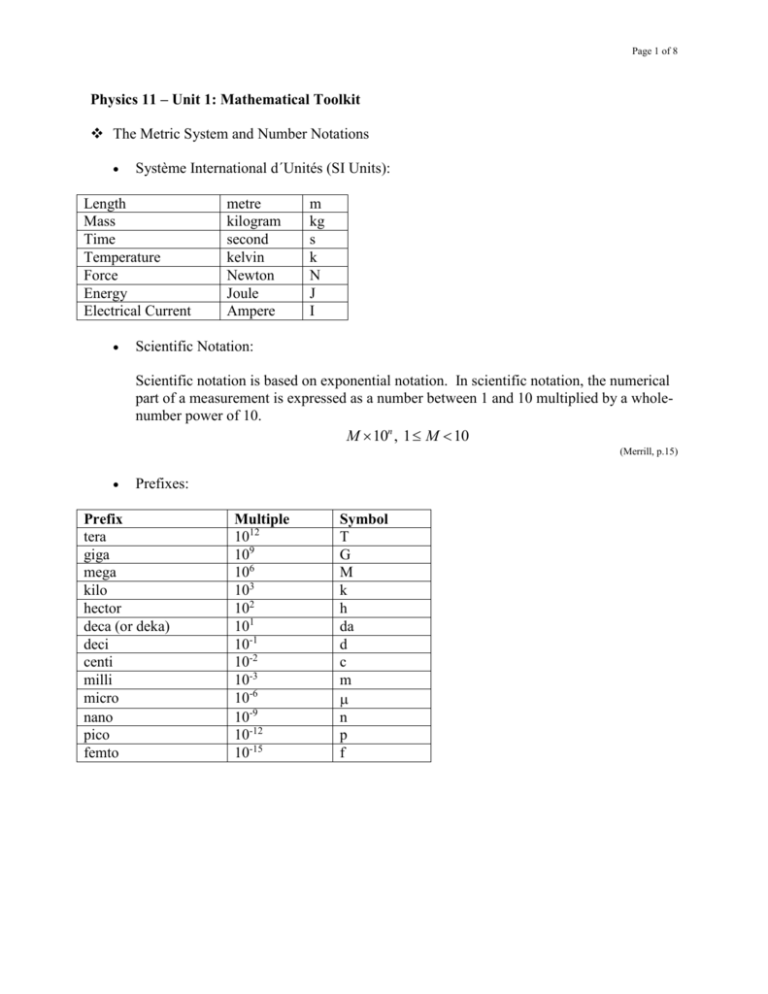
Page 1 of 8 Physics 11 – Unit 1: Mathematical Toolkit The Metric System and Number Notations Système International d´Unités (SI Units): Length Mass Time Temperature Force Energy Electrical Current metre kilogram second kelvin Newton Joule Ampere m kg s k N J I Scientific Notation: Scientific notation is based on exponential notation. In scientific notation, the numerical part of a measurement is expressed as a number between 1 and 10 multiplied by a wholenumber power of 10. M 10n , 1 M 10 (Merrill, p.15) Prefixes: Prefix tera giga mega kilo hector deca (or deka) deci centi milli micro nano pico femto Multiple 1012 109 106 103 102 101 10-1 10-2 10-3 10-6 10-9 10-12 10-15 Symbol T G M k h da d c m n p f Page 2 of 8 Uncertainty in Measurements Precision and Accuracy: - Precision is the degree of exactness to which the measurement of a quantity can be reproduced. The precision of an instrument is limited by the smallest division on the measurement scale. - Accuracy is the extent to which a measured value agrees with the standard value of a quantity. The accuracy of a measurement describes how well the result agrees with an accepted value. (Merrill, p. 21-22) (a) precise and accurate (b) precise but not accurate (c) neither precise nor accurate Significant Digits: Significant digits are all the digits that are certain plus a digit that estimates the fraction of the smallest division of the measuring scale. Follow these rules to decide if a digit is significant: 1. 2. 3. 4. Nonzero digits are always significant. e.g. 1234 – 4 s.d. All final zeros after the decimal point are significant. e.g. 6.00 – 3 s.d. Zeros between two other significant digits are always significant. e.g. 2005 – 4 s.d. Zeros to the right of a whole number are considered to be ambiguous. e.g. 300 – 1 s.d. (Merrill, p. 22-23) Operations Using Significant Digits: - e.g. The sum or difference of two values is as precise as the least precise value. 12.345 1.23 13.575 13.58 Page 3 of 8 - e.g. The number of significant digits in a product or quotient is the number in the factor with the lesser number of significant digits. 12.345 12345 . 15.2399025 15.240 (Merrill, p. 24-25) The Errors: - Random Error results when an estimate is made to obtain the last significant digit for any measurement. e.g. When measuring length, it is necessary to estimate between the marks on the measuring tape. If thee marks are 1 cm apart, the random error will be greater and the precision will be less than if the marks are 1 mm apart. - Systematic Error is associated with an inherent problem with the measuring system, such as the presence of an interfering substance, incorrect calibration, or room conditions. e.g. If the balance is not zeroed at the beginning, all measurements will have a systematic error; using a slightly worn metre stick will also introduce error. - % error % error = experimental value - accepted value 100% accepted value e.g. When we measured the speed of sound, we found it to be 342 m/s. The accepted values at the same temperature is 352 m/s. 342 - 352 100% = - 2.84% 352 The negative sign indicates that our measured value was less than the accepted value. % error = - % difference % difference = difference in measurements 100% average measurement e.g. If two measurements of the speed of sound are 342 m/s and 348 m/s. Their % difference is: 6.00 % difference = 100% = 2.00% 345 (Hirsch, Martindale, Bibla & Stewart, p. 565; Heath, Macnaughton & Martindale, p. 553-554) Page 4 of 8 Graphing Scientific Data The procedures: 1. Choosing the Axes: Determine which of the physical quantities is the dependent variable and which is the independent variable. The independent variable is plotted on the horizontal axis and the dependent variable on the vertical axis. (y versus x) 2. Scaling the Axes: When choosing scales, spread the measured values across the graph paper as widely as possible. The scales chosen must be easy to read and must have equal divisions. Each axis is labeled with the symbol for what is being plotted and the unit. 3. Plotting the Date: Find each data point and mark it with a small dot in pencil. Around each dot draw a small circle not exceeding two small scale divisions in diameter. With a wellsharpened pencil, lightly draw in the smooth curve that best joins the small circles. Do not try to force your line to go through all dots, since experimental error will cause some points to be slightly off the smooth curve. If the points seem to lie on a straight line, use a ruler, preferably a transparent one, so that you can see all the points while selecting the best line. Sometimes a point obviously has no experimental error, so the line must go through it. (Heath, Macnaughton & Martindale, p. 554-555) Linear Equations: m yR y L , y = mx + y0 xR x L m is the slope of line and y0 is the initial value on the vertical axis (y intercept) Quadratic Equations: y cx 2 y0 c is vertical factor and y0 is the max. or mim. Value Reciprocal Relations: y c c or y 2 , x 0 x x c is vertical factor Radical Relations: y x, x 0 Page 5 of 8 Proportioning Techniques The statement of how one quantity varies in relation to another is called a proportionality expression. e.g. Time (s) Distance (m) 1 28 2 56 3 84 4 112 5 140 6 168 7 196 dt e.g. The force of air resistance (F) on a moving body is related to the speed of the body (v) by the proportion F v2. If the speed triples, how many times greater is the force? e.g. The cylindrical water tank holds 1.0 105 L of water. How much would it hold if all of its dimensions were doubled? Manipulating Equations Page 6 of 8 e.g. Find l, if T l . g e.g. Find i, if ni sin i nr sin r . e.g. Find d i, if 1 1 1 . f d o di e.g. Find v i, if v 2f vi2 2ad . Conversion of Units e.g. Changes 4.5 km to cm. e.g. How many s are contained in 2.5 h? e.g. Convert 80.0 km/s to m/s. Physics 11 - Unit 1: Mathematic Toolkits: Practice Page 7 of 8 Page 8 of 8



